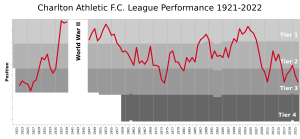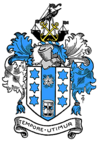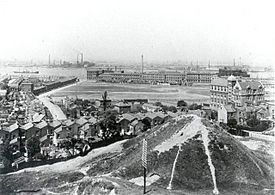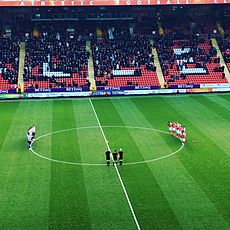Charlton Athletic F.C. facts for kids
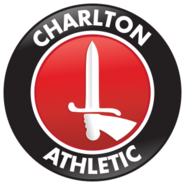 |
||
| Full name | Charlton Athletic Football Club | |
|---|---|---|
| Nickname(s) | The Addicks, The Valiants, Red Robins | |
| Founded | 9 June 1905 | |
| Ground | The Valley | |
| Capacity | 27,111 | |
| Owner | GFP (Global Football Partners) | |
| Chairman | Gavin Carter | |
| Manager | Nathan Jones | |
| League | Championship | |
| 2018–19 | League One, 3rd of 24 (promoted via play-offs) | |
|
|
||
Charlton Athletic Football Club is a professional association football team. They are based in Charlton, south-east London, England. The team plays in the EFL Championship, which is the second highest level of football in England.
Their home stadium is The Valley. The club has played there since 1919. For a few years between 1985 and 1992, they played at other stadiums like Selhurst Park and The Boleyn Ground. This was because of money problems and safety worries. Charlton's traditional uniform is red shirts, white shorts, and red socks. Their most common nickname is The Addicks. Charlton has local rivalries with other South London teams, Crystal Palace and Millwall.
The club started on June 9, 1905, and became a professional team in 1920. They joined the Football League Third Division South in 1921. Charlton won this division in 1929 and again in 1935. They were promoted to the First Division in 1936. The team finished second in the First Division the next year. After losing the FA Cup Final in 1946, they won the FA Cup in 1947. They beat Burnley 1–0.
Charlton faced some tough times, including financial problems. They were promoted back to the First Division in 1986. In 1998, Charlton won a play-off final to reach the Premier League for the first time. They were relegated the next year but came back as champions in 2000. Charlton stayed in the Premier League for seven years. They won League One in 2012 with 101 points.
Contents
Club History
How Charlton Athletic Started (1905–1946)
Charlton Athletic was formed on June 9, 1905. It was started by a group of 14 to 15-year-olds in East Street, Charlton. The club was always called "Charlton Athletic." They quickly moved up through local leagues. In their first season (1905–06), they played friendly games. Then, they joined and won the Lewisham League Division III in 1906–07.
Around this time, the nickname "The Addicks" started to be used. By 1913, Charlton became a senior team. This was the same year that Woolwich Arsenal F.C. moved to North London.
When World War I began, Charlton was one of the first clubs to stop playing. They wanted to help with the war effort. The club restarted in 1917. They played friendly games to raise money for war charities.
After the war, they joined the Kent League for one season. Then, they became professional in 1920. They were voted into the Football League in 1921. Charlton's first Football League game was in August 1921 against Exeter City. They won 1–0. In 1923, Charlton became known as "giant killers" in the FA Cup. They beat big teams like Manchester City.
In 1923, there was a plan for Charlton to merge with Catford Southend. For the 1923–24 season, Charlton played in Catford. They wore blue and white stripes. But the move didn't happen. The team returned to Charlton in 1924 and went back to their red and white colors.
Charlton won the Division Three championship in 1929. After being relegated in 1933, Jimmy Seed became manager. He led the team to their most successful period. Seed was a smart manager. He helped Charlton get promoted from the Third Division to the First Division between 1934 and 1936. They were the first club to do this.
In 1937, Charlton finished second in the First Division. They were one of the best teams in England before World War II. During the war, they won the Football League War Cup.
Success and Challenges (1946–1984)
Charlton reached the 1946 FA Cup Final but lost to Derby County. The next year, in the 1947 FA Cup Final, they won the FA Cup! They beat Burnley 1–0. During this time, Charlton had huge crowds. The Valley was one of the biggest stadiums.
However, in the 1950s, the club didn't invest much in new players or the stadium. This slowed their growth. In 1956, manager Jimmy Seed left. Charlton was relegated the next year. From the late 1950s to the early 1970s, Charlton stayed in the Second Division. They were relegated to the Third Division in 1972.
Support for the team dropped. Even a promotion in 1975 didn't help much. In 1979–80, Charlton was relegated again. But they quickly got promoted back in 1980–81. This led to a time of big changes for the club.
Playing Away from Home (1985–1992)
In 1984, the club faced serious money problems. They had to be reformed as Charlton Athletic (1984) Ltd. Their finances were still not good. They were forced to leave The Valley in 1985. This was because of safety concerns after a stadium fire at another club.
Charlton started sharing a stadium with Crystal Palace at Selhurst Park. This was meant to be a long-term plan. Charlton didn't have enough money to fix The Valley.
Even though they moved, Charlton was promoted to the First Division in 1986. They stayed in the top league for four years. They often avoided relegation at the last minute. In 1987, Charlton played at Wembley again. They played in the Full Members Cup final.
Charlton was relegated in 1990. Manager Lennie Lawrence left. Alan Curbishley and Steve Gritt became joint player-managers. They had a good first season. But the club had to sell players to help pay for the return to The Valley. Fans formed the "Valley Party" to push for the club's return. Charlton finally came back to The Valley in December 1992. They celebrated with a 1–0 win.
Premier League Years (1998–2007)
In 1995, Richard Murray became the new chairman. He made Alan Curbishley the sole manager. Under Curbishley, Charlton reached the Division One play-off final in 1998. They played Sunderland in a very exciting game. It ended 4–4 after extra time. Charlton won 7–6 on penalties. This win promoted them to the Premier League.
Charlton's first Premier League season started well. But they couldn't keep up the good form and were relegated. The club's board trusted Curbishley. He led them to win the Division One title in 2000, bringing them back to the Premier League.
Curbishley was good at finding new players. By 2003, he had made Charlton a strong team in the top league. In the 2003–04 Premier League season, Charlton almost qualified for the Champions League. They finished seventh, which was their highest finish since the 1950s.
Curbishley left in 2006. Iain Dowie became manager but was sacked after only 12 games. Les Reed took over but was also replaced by Alan Pardew. Pardew improved results, but Charlton was relegated at the end of the season.
Back in the Football League (2007–2014)
Charlton's return to the second tier was tough. They finished 11th. In 2008, the club faced big financial losses. Pardew left in November 2008. Phil Parkinson became caretaker manager. The team went 18 games without a win, a new club record. They were relegated to League One in April 2009.
In the 2009–10 season, Charlton almost reached the play-offs. After a change in ownership, Parkinson left. Another Charlton legend, Chris Powell, became manager in January 2011.
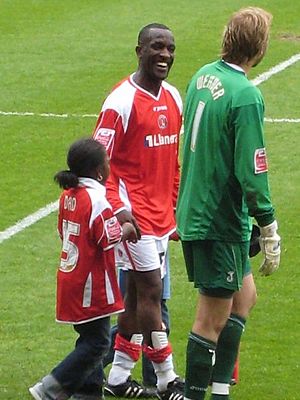
Powell brought in many new players. On April 14, 2012, Charlton won promotion back to the Championship. A week later, they were confirmed as champions of League One. They finished with 101 points, their highest ever score. In their first season back in the Championship (2012–13), Charlton finished ninth.
New Owners and Challenges (2014–2019)
In January 2014, Belgian businessman Roland Duchâtelet bought Charlton. This made Charlton part of a group of football clubs owned by Duchâtelet. In March 2014, manager Chris Powell was sacked. Jose Riga took over and helped the team avoid relegation.
After Riga left, Bob Peeters became manager in May 2014. He was dismissed after only 25 games. Guy Luzon replaced him. Luzon helped the team finish 12th.
The 2015–16 season was difficult. Luzon was sacked in October 2015. Karel Fraeye became "interim head coach" but was also sacked. Jose Riga returned for a second time but couldn't stop Charlton from being relegated to League One. Riga resigned. Many fans felt the club was being managed poorly.
Russell Slade was appointed manager in June 2016 but left in November. Karl Robinson took over. He led the team to challenge for the play-offs. He was replaced by former player Lee Bowyer as caretaker manager. Bowyer guided them to a 6th-place finish.
Bowyer became permanent manager. He led Charlton to third place in the 2018–19 EFL League One season. They qualified for the play-offs. Charlton beat Sunderland 2–1 in the League One play-off final. This earned them promotion back to the EFL Championship.
Changes in Ownership (2019–Present)
In November 2019, East Street Investments (ESI) bought Charlton Athletic. However, there were problems between the new owners. The English Football League (EFL) said the takeover was not fully approved. The club faced a transfer ban.
In June 2020, a new group led by Paul Elliott took over ESI. But legal disputes continued. In August 2020, the EFL said some new owners failed their tests. Charlton was relegated to League One at the end of the 2019–20 season. Most games were played without fans because of the COVID-19 pandemic.
In September 2020, Thomas Sandgaard, a Danish businessman, bought the club. He passed the EFL's tests. In March 2021, Lee Bowyer resigned as manager. Nigel Adkins was appointed. The club finished seventh in the 2020–21 season. But they started the next season poorly, and Adkins was sacked in October 2021.
Johnnie Jackson became manager in December 2021. Charlton finished 13th, and Jackson was also sacked. Ben Garner was appointed in June 2022 but was sacked in December. Fans were worried about the club's future. Dean Holden became manager in December 2022. Charlton improved and finished 10th in the 2022–23 season.
On June 5, 2023, SE7 Partners took over Charlton Athletic. This was the club's fourth owner in less than four years. Holden was sacked in August 2023. Michael Appleton replaced him but was sacked in January 2024. Nathan Jones became manager in February 2024. Charlton had a tough start but then went on a 14-match unbeaten run. They finished 16th, their worst league position in 98 years. However, striker Alfie May won the League One Golden Boot award with 23 goals. On May 25, 2025, Charlton won promotion back to the Championship by winning the League One play-off final 1–0 against Leyton Orient.
Club Identity
Team Colors and Crest
Charlton has used different crests over the years. The current design has been used since 1968. The first known badge from the 1930s had the letters CAF. In the 1940s, a robin sitting in a football was used. For a short time, the crest of the Greenwich borough was used.
In 1963, a competition was held to find a new badge. The winning design was a hand holding a sword. This matched Charlton's nickname at the time, "The Valiants." Over the next five years, this design was changed. By 1968, it became the one we see today.
Charlton has almost always played in red and white. These colors were chosen by the boys who started the club in 1905. They had borrowed kits from their local rivals, Woolwich Arsenal, who also played in red and white. The only exception was part of the 1923–24 season. Charlton wore blue and white stripes then. But they soon went back to red and white.
| Year | Kit manufacturer | Main shirt sponsor | Back of shirt sponsor | Shorts sponsor |
|---|---|---|---|---|
| 1974–80 | Bukta | None | None | |
| 1980–81 | Adidas | |||
| 1981–82 | FADS | |||
| 1982–83 | None | |||
| 1983–84 | Osca | |||
| 1984–86 | The Woolwich | |||
| 1986–88 | Adidas | |||
| 1988–92 | Admiral | |||
| 1992–93 | Ribero | None | ||
| 1993–94 | Viglen | |||
| 1994–98 | Quaser | |||
| 1998–00 | Le Coq Sportif | MESH | ||
| 2000–02 | Redbus | |||
| 2002–03 | All:Sports | |||
| 2003–05 | Joma | |||
| 2005–08 | Llanera | |||
| 2008–09 | Carbrini Sportswear | |||
| 2009 | Kent Reliance Building Society | |||
| 2010–12 | Macron | |||
| 2012–14 | Nike | Andrews Sykes | ||
| 2014–16 | University of Greenwich | Andrews Sykes | Mitsubishi Electric | |
| 2016–17 | BETDAQ | ITRM | Emmaus Consulting | |
| 2017–19 | Hummel | Gaughan Services | ||
| 2019–20 | Children with Cancer UK | Cannon Glass | ||
| 2020–21 | KW Holdings (home) Vitech Services (away) |
|||
| 2021–22 | KW Holdings (home & third) Walker Mower (away) |
|||
| 2022–25 | Castore | RSK (home) University of Greenwich (away) |
Generous Robots DAO | |
| 2025– | Reebok | RSK Group | TBA | TBA |
Team Nicknames
Charlton's most common nickname is The Addicks. This name comes from a local fish seller, Arthur "Ikey" Bryan. He used to give the team meals of haddock and chips.
Early cartoons about the team called them "Haddocks" in 1908. By 1910, it changed to "Addicks." The club also has two other nicknames: "The Robins," used since 1931, and "The Valiants," chosen in a fan competition in the 1960s. The "Addicks" nickname was brought back by fans after the club lost its home at The Valley in 1985. It is now the official nickname.
Charlton fans have a song called "Valley, Floyd Road." It's about the stadium's address and is sung to the tune of "Mull of Kintyre."
The Stadium: The Valley
Charlton's first ground was Siemens Meadow (1905–1907). It was a rough field near the River Thames. They then played at other places like Woolwich Common and Pound Park. After World War I, a chalk quarry called the Swamps became Charlton's new ground. In 1919, work began to make it a proper playing field.
The first match at this new site, now known as The Valley, was in September 1919. Charlton played at The Valley until 1923. Then, they moved to The Mount stadium in Catford. This was part of a plan to merge with another team. But the move didn't happen, and Charlton returned to The Valley in 1924.
In the 1930s and 1940s, The Valley was greatly improved. It became one of the biggest stadiums in the country. In 1938, over 75,000 people watched an FA Cup match there. In the 1940s and 1950s, crowds were often over 40,000. But after the club was relegated, The Valley was not kept up.
In the 1980s, the club faced problems with the stadium. Part of the ground was closed for safety reasons. In September 1985, Charlton had to share a stadium with Crystal Palace at Selhurst Park. Many fans were unhappy about this. They worked hard to bring the club back to The Valley.
A political group called the "Valley Party" was formed. They wanted the stadium reopened. Fans also created the "Valley Gold" plan to help raise money. Charlton played at Upton Park for a while. Finally, Charlton returned to The Valley in December 1992.
Since returning, three sides of the stadium have been rebuilt. It is now a modern, all-seater stadium with a capacity of 27,111. This is the biggest stadium in South London. There are plans to make it even bigger in the future. In May 2024, a new Desso GrassMaster pitch was installed.
Fans and Rivalries
Most of Charlton's fans come from South East London and Kent. Fans played a big part in bringing the club back to The Valley in 1992. They were given a voice on the club's board. This role was later replaced by a fans forum, which still meets today.
Charlton's main rivals are their South London neighbors, Crystal Palace and Millwall.
In 1985, Charlton had to share Selhurst Park with Crystal Palace. This was not popular with fans of either team. In 2005, Charlton played a game against Palace that led to Palace being relegated. Charlton equalized with seven minutes left, which meant Palace couldn't stay in the league. Since their first meeting in 1925, Charlton has won 17 games, drawn 13, and lost 26 against Palace. They last played in 2015.
Charlton is very close to Millwall. Their stadiums are less than four miles apart. They last played in July 2020. Since their first Football League game in 1921, Charlton has won 11, drawn 26, and lost 37 league games against Millwall. Charlton has not beaten Millwall in their last 12 league games. Their last win was in 1996.
Club Records and Statistics
- Sam Bartram played the most games for Charlton, with 623 appearances between 1934 and 1956.
- Keith Peacock is second with 591 games. He was also the first-ever substitute in a Football League game in 1965.
- Radostin Kishishev played for Bulgaria 42 times while at Charlton, more than any other Charlton player.
- 12 Charlton players have played for the England national team.
- Derek Hales is Charlton's top goalscorer with 168 goals in 368 matches.
- Stuart Leary scored the most league goals, with 153.
- The most goals scored in one season is 33 by Ralph Allen in 1934–35.
- Charlton's record home attendance is 75,031. This was for an FA Cup match against Aston Villa in 1938.
- The record attendance for the current all-seater stadium is 27,111. This was first set in 2005 against Chelsea.
| Achievement | Record (year, division) |
|---|---|
| Highest league finish | Runners-up in 1936–37 (First Division) |
| Most league points in a season | 101 in 2011–2012 (League One) |
| Most league goals in a season | 107 in 1957–58 (Second Division) |
| Record victory | 8–0 v. Stevenage, 9 October 2018 |
| Record away victory | 8–0 v. Stevenage, 9 October 2018 |
| Record defeat | 1–11 v. Aston Villa, 14 November 1959 |
| Record FA Cup victory | 7–0 v. Burton Albion, 7 January 1956 |
| Record League Cup victory | 5–0 v. Brentford, 12 August 1980 |
| Most successive victories | 12 matches (from 26 December 1999 to 7 March 2000) |
| Most games without a win | 18 matches (from 18 October 2008 to 13 January 2009; and 2 December 2023 to 24 February 2024) |
| Most successive defeats | 10 matches (from 11 April 1990 to 15 September 1990) |
| Most successive draws | 6 matches (from 13 December 1992 to 16 January 1993) |
| Longest unbeaten | 15 matches (from 4 October 1980 to 20 December 1980) |
| Record attendance | 75,031 v. Aston Villa, 17 October 1938 |
| Record league attendance | 68,160 v. Arsenal, 17 October 1936 |
| Record gate receipts | £400,920 v. Leicester City, 19 February 2005 |
Player Records
| Achievement | Player (record) |
|---|---|
| Most appearances | Sam Bartram (623) |
| Most appearances (outfield) | Keith Peacock (591) |
| Most goals | Derek Hales (168) |
| Most hat-tricks | Johnny Summers and Eddie Firmani (8) |
| Most capped player | Dennis Rommedahl (126) |
| Most capped player while at the club | Radostin Kishishev (42) |
| Oldest player | Sam Bartram (42 years and 47 days) |
| Youngest player | Jonjo Shelvey (16 years and 59 days) |
| Oldest scorer | Chris Powell (38 years and 239 days) |
| Youngest scorer | Jonjo Shelvey (16 years and 310 days) |
| Quickest scorer | Jim Melrose (9 seconds) |
| Quickest sending off | Naby Sarr (1 minute) |
Players
First-team Squad
|
|
Under-21s Squad
|
|
Under-18s Squad
|
|
Women's Team
Player of the Year Awards
- 1971
 Paul Went
Paul Went - 1972
 Keith Peacock
Keith Peacock - 1973
 Arthur Horsfield
Arthur Horsfield - 1974
 John Dunn
John Dunn - 1975
 Richie Bowman
Richie Bowman - 1976
 Derek Hales
Derek Hales - 1977
 Mike Flanagan
Mike Flanagan - 1978
 Keith Peacock
Keith Peacock - 1979
 Keith Peacock
Keith Peacock - 1980
 Les Berry
Les Berry - 1981
 Nicky Johns
Nicky Johns - 1982
 Terry Naylor
Terry Naylor - 1983
 Nicky Johns
Nicky Johns - 1984
 Nicky Johns
Nicky Johns - 1985
 Mark Aizlewood
Mark Aizlewood - 1986
 Mark Aizlewood
Mark Aizlewood - 1987
 Bob Bolder
Bob Bolder - 1988
 John Humphrey
John Humphrey - 1989
 John Humphrey
John Humphrey - 1990
 John Humphrey
John Humphrey - 1991
 Rob Lee
Rob Lee - 1992
 Simon Webster
Simon Webster - 1993
 Stuart Balmer
Stuart Balmer - 1994
 Carl Leaburn
Carl Leaburn - 1995
 Richard Rufus
Richard Rufus - 1996
 John Robinson
John Robinson - 1997
 Andy Petterson
Andy Petterson - 1998
 Mark Kinsella
Mark Kinsella - 1999
 Mark Kinsella
Mark Kinsella - 2000
 Richard Rufus
Richard Rufus - 2001
 Richard Rufus
Richard Rufus - 2002
 Dean Kiely
Dean Kiely - 2003
 Scott Parker
Scott Parker - 2004
 Dean Kiely
Dean Kiely - 2005
 Luke Young
Luke Young - 2006
 Darren Bent
Darren Bent - 2007
 Scott Carson
Scott Carson - 2008
 Matt Holland
Matt Holland - 2009
 Nicky Bailey
Nicky Bailey - 2010
 Christian Dailly
Christian Dailly - 2011
 José Semedo
José Semedo - 2012
 Chris Solly
Chris Solly - 2013
 Chris Solly
Chris Solly - 2014
 Diego Poyet
Diego Poyet - 2015
 Jordan Cousins
Jordan Cousins - 2016
 Jordan Cousins
Jordan Cousins - 2017
 Ricky Holmes
Ricky Holmes - 2018
 Jay DaSilva
Jay DaSilva - 2019
 Lyle Taylor
Lyle Taylor - 2020
 Dillon Phillips
Dillon Phillips - 2021
 Jake Forster-Caskey
Jake Forster-Caskey - 2022
 George Dobson
George Dobson - 2023
 Jesurun Rak-Sakyi
Jesurun Rak-Sakyi - 2024
 Alfie May
Alfie May - 2025
 Lloyd Jones
Lloyd Jones
Club Officials
Coaching Staff
Managerial History
| Name | Dates | Achievements |
|---|---|---|
| June 1920 – May 1925 | ||
| May 1925 – January 1928 | ||
| January 1928 – June 1928 | ||
| June 1928 – December 1932 | Third Division champions (1929) | |
| December 1932 – May 1933 | ||
| May 1933 – September 1956 | Third Division champions (1935); Second Division runners-up (1936); First Division runners-up (1937); Football League War Cup co-winners (1944); FA Cup runners-up 1946; FA Cup winners 1947 |
|
| September 1956 | ||
| September 1956 – October 1961 | ||
| October 1961 – November 1961 | ||
| November 1961 – August 1965 | ||
| August 1965 – September 1967 | ||
| September 1967 – March 1970 | ||
| March 1970 – April 1974 | ||
| April 1974 – May 1974 | ||
| May 1974 – March 1980 | Third Division 3rd place (promoted; 1975) | |
| March 1980 – June 1981 | Third Division 3rd place (promoted; 1981) | |
| June 1981 – June 1982 | ||
| June 1982 – November 1982 | ||
| November 1982 – July 1991 | Division Two runners-up (1986); Full Members Cup runners-up (1987) |
|
| July 1991 – June 1995 | ||
| June 1995 – May 2006 | First Division play-off winners (1998); First Division champions (2000) |
|
| May 2006 – November 2006 | ||
| November 2006 – December 2006 | ||
| December 2006 – November 2008 | ||
| November 2008 – January 2011 | ||
| January 2011 | ||
| January 2011 – March 2014 | League One champions (2012) | |
| March 2014 – May 2014 | ||
| May 2014 – January 2015 | ||
| January 2015 | ||
| January 2015 – October 2015 | ||
| October 2015 – January 2016 | ||
| January 2016 – May 2016 | ||
| June 2016 – November 2016 | ||
| November 2016 | ||
| November 2016 – March 2018 | ||
| March 2018 – September 2018 | ||
| September 2018 – March 2021 | League One play-off winners (2019) | |
| March 2021 | ||
| March 2021 – October 2021 | ||
| October 2021 – December 2021 | ||
| December 2021 – May 2022 | ||
| June 2022 – December 2022 | ||
| December 2022 | ||
| December 2022 – August 2023 | ||
| August 2023 – September 2023 | ||
| September 2023 – January 2024 | ||
| January 2024 – February 2024 | ||
| February 2024 – | League One play-off winners (2025) |
List of Chairmen
| Year | Name |
|---|---|
| 1921–1924 | Douglas Oliver |
| 1924–1932 | Edwin Radford |
| 1932–1951 | Albert Gliksten |
| 1951–1962 | Stanley Gliksten |
| 1962–1982 | Michael Gliksten |
| 1982–1983 | Mark Hulyer |
| 1983 | Richard Collins |
| 1983–1984 | Mark Hulyer |
| 1984 | John Fryer |
| 1984–1985 | Jimmy Hill |
| 1985–1987 | John Fryer |
| 1987–1989 | Richard Collins |
| 1989–1995 | Roger Alwen |
| 1995–2008 | Richard Murray (PLC) |
| 1995–2008 | Martin Simons |
| 2008–2010 | Derek Chappell |
| 2008–2010 | Richard Murray |
| 2010–2014 | Michael Slater |
| 2014–2020 | Richard Murray |
| 2020 | Matt Southall |
| 2020–2023 | Thomas Sandgaard |
| 2024 | James Rodwell |
| 2024– | Gavin Carter |
Club Achievements
Source:
League Titles
- First Division (level 1)
- Runners-up: 1936–37
- Second Division / First Division (level 2)
- Champions: 1999–2000
- 2nd place promotion: 1935–36, 1985–86
- Play-off winners: 1987, 1998
- Third Division South / Third Division / League One (level 3)
- Champions: 1928–29 (South), 1934–35 (South), 2011–12
- 3rd place promotion: 1974–75, 1980–81
- Play-off winners: 2019, 2025
Cup Wins
- FA Cup
- Winners: 1946–47
- Runners-up: 1945–46
- Full Members' Cup
- Runners-up: 1986–87
- Football League War Cup
- Joint winners: 1943–44
- Kent Senior Cup
- Winners: 1994–95, 2012–13, 2014–15
- Runners-up: 1995–96, 2015–16
- London Senior Cup
- Winners: 2022–23, 2023–24
See also
 In Spanish: Charlton Athletic Football Club para niños
In Spanish: Charlton Athletic Football Club para niños
- Football in London


